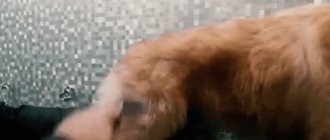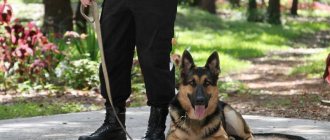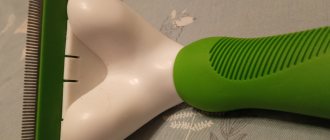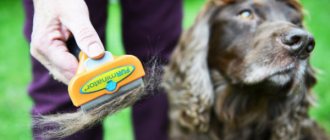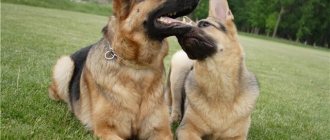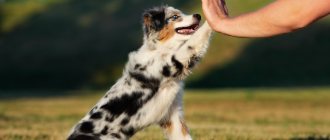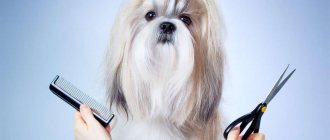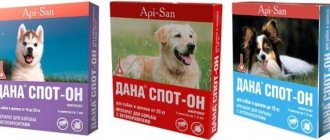To maintain a neat appearance of the animal, dogs periodically need to do trimming - this is plucking out dead remnants of fur. The coat of any dog is unique, but according to the general classification, all breeds can be divided into three types: wire-haired, short-haired and long-haired. The first type does not have a natural molting process.
What is dog trimming
A unique cosmetic procedure for cleaning the coat of some breeds is called dog trimming. In fact, this is plucking out dead hairs. You might think that the animal will be uncomfortable, but in fact the process brings him relief.
In their natural habitat, dogs got rid of excess hair by rubbing against plants and trees. In apartment living conditions, the owner must take care of how to properly trim the dog.
Important: haircut and trimming are different events. You cannot replace one with the other.
Haircut types
Model
This haircut is based on the breed standard, the skill of the master and the imagination of the owner . With the help of a model haircut, noticeable defects of the animal are hidden.
There is not a wide variety of model haircuts for wire-haired dachshunds. It is possible to cut the hair on the bridge of the nose into a triangle, give the beard an unusual shape, or tint the eyebrows.
Hygienic
Conducted to maintain the health and cleanliness of the dachshund. It is recommended to do a hygienic haircut every 2-4 weeks.
The haircut package includes:
- cutting and shaving the hair at the groin and anus, at the base of the tail;
- cutting the hair between the fingers;
- trimming ears inside and out;
- trimming mustache, beard and eyebrows, under the eyes.
Cosmetic
After complete grooming, a cosmetic haircut is required once every 1-2 weeks . Helps maintain the shape of the beard, mustache and eyebrows, during which unwanted regrown hairs are removed.
There is also an exhibition haircut . Conducted in accordance with the standard. It is not advisable to hide a dog's shortcomings with a haircut. This is unsportsmanlike; at the exhibition, experienced judges will reveal the deception.
Why is it needed?
The priority when choosing wire-haired breeds over others is the lack of shedding. But this statement is not entirely true. Their coat does not shed on its own; help is needed. If the animal is not trimmed, it will lose its presentable appearance. A simple haircut is not enough here.
Expert opinion
Anna Abramenko
An avid dog lover. Experience in veterinary medicine since 2009.
Ask a Question
Coarse hair is given to these breeds in order to protect them from injury and save them from weather disasters. Such wool is not blown through by the wind, thorns and insects do not stick. Haircut disrupts their unique structure, the hairs become thin, lose their properties and grow poorly.
The hair structure of wire-haired quadrupeds has its own peculiarities. The upper part is thicker and the lower part is thinner. During cutting, the outer half is shortened. After this, the lower, thin and weak one begins to grow. There is a failure in the change of coat and its appearance becomes pale, the natural color is lost and the quality of the hair deteriorates. Subsequently, tangles form that do not allow air to pass through to the skin, and a fungus appears in the layer between the body and the undercoat.
Attention: if it happens that plucking was not carried out, but the animal was periodically clipped, it is impossible to restore the coat. The dog should be taken to a professional groomer for service and grooming.
Haircut for boys
Wirehaired dachshund boys are given “pants.” With this haircut, the hair on the back and sides is made short, on the paws and belly it remains grown and trimmed a little with scissors.
The beard and mustache are left as long as possible, which gives the dog a serious look . Or they cut it on the sides, leaving a wedge-shaped beard in front and a mustache.
Varieties
It is better to trim an animal for the first time under the supervision of a specialist, so as not to cause injury. The pain caused can prevent the four-legged animal from plucking for a long time. There are two ways to remove dead hair:
- Stripping (carried out using tools).
- Plaking (manual processing).
There are also types of dead hair removal procedures, depending on the desired result:
- Exhibition. Conducted before the competition, the result must meet the selection criteria.
- Cosmetic. Its goal is a beautiful appearance, carried out as part of the four-legged care procedures.
- Hygienic. It is required when the wool is neglected and the formation of “armor” from tangles has begun.
Trimming also happens:
- Full. It is carried out if more than 4 months have passed since the last procedure. Often combined with thinning the undercoat.
- Easy. Do it once every 2-3 months without cutting the undercoat.
Training
In order for the owner and the dog to live comfortably in the same territory and not have to be ashamed of their pet’s behavior on the street, the fox terrier is raised and trained from an early age. First of all, the puppy must remember its name. You need to stroke him more often and at the same time repeat his name with the same intonation without diminutive derivatives.
At the same time, the pet is introduced to family members. Each named person in turn approaches the dog and gives a piece of treat. Repeat his name and the names of household members daily until the puppy remembers the information.
They get used to the collar gradually, each time increasing the time it is worn. When the fox terrier stops reacting to a foreign object placed around its neck, attach a leash. During the first walks, the owner adjusts to the dog’s step so that there is no sudden tension on the leash.
Stop the puppy from trying to ask for food during a family feast, jumping on the owner with its paws, or chewing shoes and furniture. The Fox Terrier can be trained to relieve itself outdoors and in the litter tray, following a command that you need to come up with yourself.
Next, the dog is trained to stand, sit, lie down on command, walk next to the owner, and come at the first call. During the training process, each execution of a command is reinforced with a treat. If you lack knowledge and patience, it is better to give the dog to an experienced instructor for a general training course.
A show dog is taught to respond appropriately to the touch of someone else's hands. She should not be nervous when examining her teeth, stroking her, or working with a groomer.
If you approach raising a fox terrier with patience and love, then the puppy will grow into a devoted friend and companion, ready to carry out any command in order to hear a kind word from the owner.
When is trimming done?
The first time the process occurs when the puppy is six months old or a little less. The time of molting is favorable for this (spring and autumn). Next time you can pluck after 6 months. During this time, the coat will have time to renew itself, and the old hairs will die off. There are some nuances regarding individual breeds, but on average the frequency is the same.
The time for pinching can be easily determined by the appearance of the four-legged animal. The cover begins to bristle and looks sloppy. The hairs become thinner and stick out in different directions. You can run your hand against the grain, if something remains on your fingers, the time has come.
Interesting: plucking improves the quality of the coat. New hairs grow thicker and shine. For an exhibition, for example, you need to pluck once every 2 weeks so that the coat is renewed, thicker and looks presentable.
Breeds and frequency of pinching
Animals of wire-haired breeds and dogs with mixed hair types need to be plucked. This may include:
- fox terrier;
- Airedale Terrier;
- Welsh Terrier;
- Scottish Terrier;
- miniature schnauzer;
- Giant Schnauzer;
- miniature schnauzer;
- drathaara;
- wirehaired dachshund.
Puppies of different types of schnauzer breeds are subjected to the first plucking at the age of six months, dogs of large breeds - from 7-8 months.
Light trimming is best done three times a month, full trimming - 2 times annually. The best time for trimming is autumn and spring, when dogs begin to shed seasonally. If you plan to participate in competitions, you need to pluck your hair several months before the start of the exhibition. This does not apply only to schnauzers; their hair growth cycle lasts a little longer - up to six months. In this case, plucking can be done 4 months before the competition.
To find out for yourself whether the time has come for trimming, you need to lightly squeeze a small tuft of fur in your palm and gently pull. If there are hairs left in your hand, this indicates the need for this procedure. You can do this yourself or contact an experienced groomer.
Dog trimming tools with descriptions
Before carrying out the event at home, you need to familiarize yourself with the list of tools for trimming dogs.
- Table. The dog should not feel uncomfortable. A rough surface will do. The owner should also be comfortable.
- Trimming knife. This tool was created specifically for wire-haired four-legged animals and has replaceable blades. Stainless steel will protect against infection. The blades pinch the undercoat and thick hair.
- Cleansing stone. It is used after pinching. The purpose of the stone is to remove the remains of dead hairs. Reminds the action of pumice.
- Knife made of stone. Used for places that are difficult to reach, such as the ears.
- Brush. This tool must be stiff in order to thoroughly comb out the hairs that have been plucked.
- Chalk (powder). Used on the skin for disinfection.
- Thimble. To protect the groomer. Some people pluck the fur with their bare hands, but the procedure is lengthy and it is better to be on the safe side.
Who is the Wirehaired Dachshund suitable for?
Since Geese are very energetic dogs, they need an equally active owner. He must be prepared for long walks and intense play with the pet. The future owner must be quite patient, because there will be a lot of noise and mischief in his house.
Therefore, people who lead a measured and calm lifestyle and are not ready for its radical change should not start using gestures.
How to choose a rough-haired dachshund puppy?
Rules to help you choose a wire-haired puppy:
- contact only official nurseries with an established reputation;
- you need to study the baby’s pedigree: what his parents and brothers and sisters look like, whether they are sick with anything;
- it is necessary to study the baby’s shelter diet;
- if the puppy does not go into your arms, does not show activity and sits in the corner - perhaps he is sick;
- you need to make sure that the puppy does not have parasites (both skin and intestinal), and that there are no discharges on his eyes and nose;
- you need to try to pick up the baby. If he freezes and tenses, he is scared. It will be more difficult to establish contact with him. If the baby does not sit in his arms and is actively struggling, perhaps he has not yet learned to calm down on his own.
But still, the main selection criterion is the call of the heart of the future owner. Any puppy deserves love and life among people.
